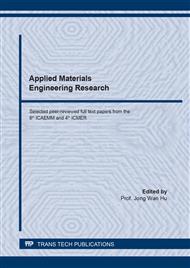[1]
H. Elmsellem, H. Nacer, F. Halaimia, A. Aouniti, I. Lakehal, A. Chetouani, S.S. Al-Deyab, R. Warad, R. Touzani, B. Hammouti, Anti-corrosive Properties and Quantum Chemical Study of (E)-4-Methoxy-N-(Methoxybenzylidene) Aniline and (E)-N-(4-Methoxybenzylidene)-4-Nitroaniline Coating on Mild Steel in Molar Hydrochloric, Int. J. Elect. Sci. 9 (2014) 5328-5351.
Google Scholar
[2]
R.T. Loto, Study of the corrosion behaviour of S32101 duplex and 410 martensitic stainless steel for application in oil refinery distillation systems, J. Mater. Res. Techn. 6(3) (2017) 203–212. https://doi.org/10.1016/j.jmrt.2016.11.001.
DOI: 10.1016/j.jmrt.2016.11.001
Google Scholar
[3]
The effects and economic impact of corrosion, Corrosion: Understanding the basics, ASM International, 2000. https://www.asminternational.org/documents/10192/1849770/06691G_Chapter_1.pdf.
Google Scholar
[4]
G. Palanisamy, Corrosion Inhibitors, IntechOpen, (2019). http://doi.org/10.5772/intechopen. 80542.
Google Scholar
[5]
V.S. Sastri, Consequences of corrosion, In Challenges in corrosion, John Wiley & Sons, Inc. Hoboken, NJ., 2015. https://doi.org/10.1002/9781119069638.ch5.
Google Scholar
[6]
K. Ahmad, Types of corrosion: Materials and Environments, in Principles of Corrosion Engineering and Corrosion Control, 1st Ed., Butterworth-Heinemann, 2006, pp.120-270.
DOI: 10.1016/b978-075065924-6/50005-2
Google Scholar
[7]
H. Elmsellem, T. Harit, A. Aouniti, F. Malek, A. Riahi, A. Chetouani, B. Hammouti, Adsorption properties and inhibition of mild steel corrosion in 1 M HCl solution by some bipyrazolic derivatives: Experimental and theoretical investigations, Prot. Met. Phys. Chem. Surf. 51 (2015) 873-884.
DOI: 10.1134/s207020511505007x
Google Scholar
[8]
F. Basile, P. Benito, G. Fornasari, M. Monti, E. Scavetta, A. Vaccari, D. Tonelli, A novel electrochemical route for the catalytic coating of metallic supports, Stud. Surf. Sci. Catal. 175 (2010) 51-58.
DOI: 10.1016/s0167-2991(10)75007-2
Google Scholar
[9]
M.P. O'Connor, R.M. Coulthard, D.L. Plata, Electrochemical deposition for the separation and recovery of metals using carbon nanotube-enabled filters, Environ. Sci. Water Res. Technol. 4 (2018) 58-66.
DOI: 10.1039/c7ew00187h
Google Scholar
[10]
L.P. Bicelli, B. Bozzini, C. Mele, L. D'Urzo, A review of nanostructural aspects of metal electrodeposition, Int. J. Elect. Sci. 3 (2008) 356 – 408.
Google Scholar
[11]
A.W. Peabody, Control of pipeline corrosion, 2nd Ed., NACE International: The Corrosion Society, Houston, Texas, (2001).
Google Scholar
[12]
A.S.M. Makhlouf, Current and advanced coating technologies for industrial applications, In book: Nanocoatings and ultra-thin-films: Technologies and applications, Woodhead Publishing Limited, Cambridge, UK, 2011. http://doi.org/10.1533/9780857094902.1.3.
DOI: 10.1533/9780857094902.1.3
Google Scholar
[13]
S. Attabi, M. Mokhtari, Y. Taibi, I. Abdel-Rahman, B. Hafez, H. Elmsellem, Electrochemical and tribological behavior of surface-treated titanium alloy Ti-6Al-4V. J. Bio Tribo Corros. 5(2) (2019. https://doi.org/10.1007/s40735-018-0193-5.
DOI: 10.1007/s40735-018-0193-5
Google Scholar
[14]
L. Yuan, Z. Ding, S. Liu, W. Shu, Y. He, Effects of additives on zinc electrodeposition from alkaline zincate solution, Trans. Nonferrous Met. Soc. China, 27(7) (2017) 1656–1664.
DOI: 10.1016/s1003-6326(17)60188-2
Google Scholar
[15]
J.B. Bajat, V.B. Mišković-Stanković, M.D. Maksimović, D.M. Dražić, S. Zec, Electrochemical deposition and characterization of Zn-Fe alloys, J. Serbian Chem. Soc. 69(10) (2004) 807–815.
DOI: 10.2298/jsc0410807b
Google Scholar
[16]
F.G. Hone, T. Abza, Short review of factors affecting chemical bath deposition method for metal chalcogenide thin films, International Journal of Thin Films Science and Technology, 8(2) (2019) 43-52. http://dx.doi.org/10.18576/ijtfst/080203.
Google Scholar
[17]
N.M. Pereira, C.M. Pereira, J.P. Araújo, A.P. Silva, Zinc electrodeposition from deep eutectic solvent containing organic additives, J. Electroanal. Chem. 801 (2017) 545–551.
DOI: 10.1016/j.jelechem.2017.08.019
Google Scholar
[18]
A.P. Abbott, J.C. Barron, G. Frisch, K.S. Ryder, A.F. Silva, The effect of additives on zinc electrodeposition from deep eutectic solvents, Electrochim. Acta, 56(14) (2011) 5272–5279.
DOI: 10.1016/j.electacta.2011.02.095
Google Scholar
[19]
Feng, L., Sun, X., Yao, S., Liu, C., Xing, W., & Zhang, J. (2014). Electrocatalysts and catalyst layers for oxygen reduction reaction, In Rotating electrode methods and oxygen reduction electrocatalysts, Elsevier B.V., Amsterdam, Vol. 175, pp.67-132. https://doi.org/10.1016/B978-0-444-63278-4.00003-3.
DOI: 10.1016/b978-0-444-63278-4.00003-3
Google Scholar
[20]
N. Sorour, W. Zhang, E. Ghali, G. Houlachi, A review of organic additives in zinc electrodeposition process (performance and evaluation), Hydrometallurgy, 171 (2017) 320–332.
DOI: 10.1016/j.hydromet.2017.06.004
Google Scholar
[21]
B. Kavitha, P. Santhosh, M. Renukadevi, A. Kalpana, P. Shakkthivel, T. Vasudevan, Role of organic additives on zinc plating, Surf. Coat. Technol. 201(6) (2006) 3438–3442.
DOI: 10.1016/j.surfcoat.2006.07.235
Google Scholar
[22]
H. Elmsellem, Y. El Ouadi, M. Mokhtari, H. Bendaif, H. Steli, A. Aouniti, A.M. Almehdi, I. Abdel-Rahman, H.S. Kusuma, B. Hammouti, A natural antioxidant and an environmentally friendly inhibitor of mild steel corrosion: A commercial oil of basil (ocimum basilicum l.), J. Univ. Chem. Technol. Metallurgy 4 (2019)742-749.
Google Scholar
[23]
R.T. Loto, Surface coverage and corrosion inhibition effect of rosmarinus officinalis and zinc oxide on the electrochemical performance of low carbon steel in dilute acid solutions, Results in Phys. 8 (2018) 172-179.
DOI: 10.1016/j.rinp.2017.12.003
Google Scholar
[24]
B. Hafez, M. Mokhtarі, H. Elmsellem, H. Steli, Environmentally friendly inhibitor of the corrosion of mild steel: Commercial oil of eucalyptus, Int. J. Corros. Scale Inhib.8(3)(2019) 573-585.
DOI: 10.17675/2305-6894-2019-8-3-8
Google Scholar
[25]
C.A. Loto, A. Olofinjana, R.T. Loto, Effect of manihot esculenta c. leaf extract additive on the zinc electroplating on mild steel in acid chloride solution. Int. J. Elect. Sci. 9 (2014) 3746 – 3759.
Google Scholar


